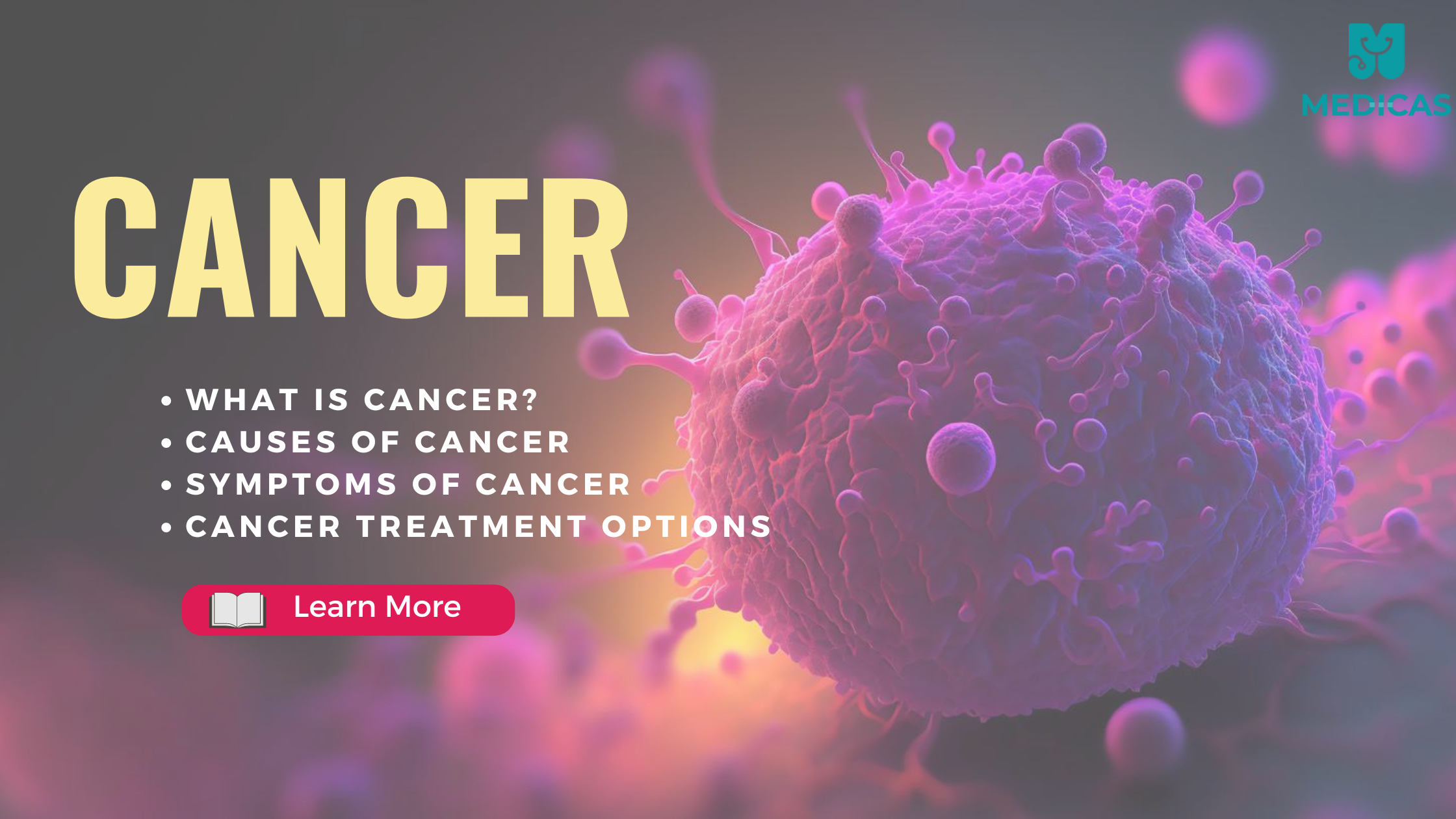What is Cancer?
Cancer isn’t one disease, but a vast umbrella term for uncontrolled cell growth that can affect any part of the body. It arises when abnormal cells in the body divide uncontrollably and spread beyond their usual boundaries. These cells can invade nearby tissues or travel through the bloodstream and lymphatic system to establish new tumors in other organs, known as metastasis. This uncontrolled growth disrupts the body’s normal functioning, leading to a variety of health problems.
What Causes Cancer?
There isn’t a single cause of cancer. It’s often a combination of factors, including:
- Genetic mutations: Changes in our DNA can lead to uncontrolled cell growth. These mutations can be inherited or acquired over time due to lifestyle choices or environmental factors.
- Lifestyle factors: Smoking, excessive alcohol consumption, unhealthy diet, and lack of physical activity at all can increase cancer risk.
- Exposure to carcinogens: Radiation, certain chemicals, and chronic infections can damage DNA and lead to cancer.
Symptoms of Cancer
Cancer symptoms can vary depending on the type or body location of the cancer. Some general signs may include:
- Unexplained weight loss or gain
- Fatigue
- Continual fever or night sweats
- Pain or tenderness in a specific area
- Changes in bowel habits
- Oddly bleeding or discharge
- Unusual lumps/bumps anywhere on the body
Types of Cancer
Cancers are categorized according to the specific cell type from which they originate. Some common types include:
- Carcinomas: These originate from epithelial cells, which cover the body’s surfaces and line organs. Examples include breast, lung and colon cancer.
- Sarcomas: These arise from connective tissues like bones, muscles, and cartilage. Examples include osteosarcoma (bone cancer) and liposarcoma (fat cancer).
- Leukemias: These affect blood-forming tissues in the bone marrow and result in abnormal blood cells.
- Lymphomas: These originate from the lymphatic system, which plays a vital role in immunity. Examples include Hodgkin lymphoma and non-Hodgkin lymphoma.
Diagnosis of Cancer
Early detection and diagnosis are crucial for successful treatment, so seeking medical attention is important if you notice any symptoms or have concerns about your health.
1. Medical History and Physical Examination: The doctor will start by taking a thorough medical history and conducting a physical examination to look for signs and symptoms of cancer.
2. Imaging Tests: Various imaging tests such as X-rays, CT scans, MRI scans, ultrasound, and PET scans can be used to create detailed pictures of the inside of the body. These images can help doctors detect tumors and determine their size, location, and whether they have spread.
3. Biopsy: A biopsy is the most definitive way to diagnose cancer. During a biopsy, a tissue sample is taken from the suspected tumor or abnormal area and examined under a microscope by a pathologist to look for cancer cells.
4. Blood Tests: Blood tests may be used to look for certain substances that can indicate the presence of cancer or provide information about how well organs are functioning. For example, tumor markers are substances that are often found at higher-than-normal levels in the blood of people with certain types of cancer.
5. Genetic Tests: Genetic tests can help identify specific gene mutations or genetic abnormalities that may increase the risk of certain types of cancer or influence treatment options.
6. Endoscopy: In this procedure, a flexible tube with a camera on the end (endoscope) is inserted into the body to examine internal organs or tissues. Endoscopy can be used to diagnose cancers of the digestive tract, respiratory tract, and other areas.
7. Bone Marrow Aspiration and Biopsy: These procedures involve taking samples of bone marrow from the hip bone to check for cancer cells or abnormalities in the bone marrow.
These diagnostic methods may be used alone or in combination, depending on the type of cancer suspected and the individual patient’s situation.
Treatment Options for Cancer
The best course of treatment depends on various factors like the type and stage of cancer, the patient’s age, and overall health. Here are some common treatment options:
- Surgery: Surgery is a common treatment for cancer. The goal of surgery is to remove the cancer as well as some of the surrounding tissue. In some cases, surgery may be used to cure cancer, while in other cases it may be used to shrink the tumor before other treatments, such as radiation therapy or chemotherapy, are given.
- Radiation therapy: To target and destroy cancer cells, radiation therapy utilizes concentrated beams of high-energy ionizing radiation. Radiation therapy can be given from a machine outside the body or from radioactive material placed inside the body.
- Chemotherapy: Chemotherapy is a type of drug treatment that uses powerful chemicals to kill cancer cells throughout the body. Chemotherapy can be given by mouth, injection, or intravenously (through a vein).
- Immunotherapy: Immunotherapy aids in empowering your body’s immune system to combat cancer. There are different types of immunotherapy, but they all work by boosting the immune system’s ability to recognize and destroy cancer cells.
- Targeted therapy: Targeted therapy drugs are designed to target specific types of cancer cells. These drugs can be more effective than traditional chemotherapy drugs and may cause fewer side effects.
Note: Obtaining a second opinion in cancer care is a proactive and valuable step that can enhance the quality of diagnosis and treatment of your health and fight cancer with a more informed and confident approach.
How to Prevent Cancer?
While there’s no guaranteed way to prevent cancer, there are several steps you can take to reduce your risk:
- Maintain a Healthy Lifestyle: You can lead a healthy lifestyle by
- Eat a balanced diet packed with essential vitamins, minerals, and fiber from fruits, vegetables, whole grains, and lean proteins.
- Limit consumption of processed and red meats.
- Avoid or limit alcohol consumption.
- Quit smoking and avoid exposure to secondhand smoke.
- Stay physically active. Target at least 150 minutes of moderate exercise or 75 minutes of vigorous exercise per week.
- Protect Yourself from the Sun:
- Use sunscreen with a high SPF, wear protective clothing, and seek shade when outdoors, especially during peak sunlight hours.
- Avoid tanning beds and sunlamps.
- Maintain a Healthy Weight:
- Aim to achieve and maintain a healthy weight through a combination of balanced diet and regular exercise.
- Get Vaccinated:
- Get vaccinated against viruses that can cause cancer, such as human papillomavirus (HPV) and hepatitis B.
Learn more
Conclusion
In conclusion, cancer is a complex and devastating disease characterized by uncontrolled cell growth that can invade and spread throughout the body. It encompasses a diverse range of conditions, each with its unique characteristics and treatment challenges. While significant progress has been made in understanding and treating cancer, it remains a leading cause of death worldwide, underscoring the urgent need for continued research, prevention efforts, and improved access to quality care. Despite its formidable nature, advancements in medical science offer hope for better outcomes and quality of life for those affected by cancer. Through multidisciplinary approaches, early detection, innovative treatments, and ongoing support, we can strive towards reducing the burden of cancer and improving the lives of individuals and communities worldwide.
Other Healthcare Blogs:
Top 10 Questions to Ask Your Oncologists for a Second Opinion
Disclaimer:
Medical Advice: The information provided in this blog post is for educational purposes only and should not be considered as a substitute for professional medical advice, diagnosis, or treatment. Always consult with a qualified healthcare professional for personalized guidance regarding your specific medical condition.
Accuracy of Information: While we strive to provide accurate and up-to-date information, the field of medicine and viral fevers is constantly evolving. The content in this blog post may not reflect the most current research or medical guidelines. Therefore, it is advisable to cross-check any information provided with reliable sources or consult a healthcare professional.
Individual Variations: The symptoms, causes, treatment options, and preventive measures discussed in this blog post are general in nature and may not apply to everyone. It is important to remember that each individual’s situation is unique, and personalized medical advice should be sought when making healthcare decisions.
External Links: This blog post may contain links to external websites or resources for additional information. However, we do not endorse or have control over the content of these third-party websites. Accessing these links is done at your own risk, and we are not responsible for any consequences or damages that may arise from visiting these external sources.
Results May Vary: The effectiveness of treatment options or preventive measures mentioned in this blog post may vary from person to person. What works for one individual may not work the same way for another. It is essential to consult with a healthcare professional for personalized advice tailored to your specific needs.

Dr. Murali serves as the Chief Medical Officer at EGS Health, bringing over 18 years of experience as a general practitioner to his role. He also directs Special Projects & Development at the Central America Health Sciences University, Belize Medical College. Dr. Murali holds an MD and a PG Cert in Health Profession Education (HPE) and has been an active contributor to the medical field since 2001. His career began in the Tobacco Cessation Program and the Border Family Welfare Programs in conjunction with PAHO in Ciudad Juarez, where he also published research on the impact of technology on healthcare education. He later became a clinical coordinator for clerkships, forging partnerships between students and hospitals that now serve as clinical sites for the university. Dr. Murali has furthered his expertise through advanced training, including the Leaders in Healthcare Education course at Harvard Macy Institute and the Health Professions Certification Program at Keele University, enhancing his influence in both medical education and healthcare delivery, both locally and internationally.


